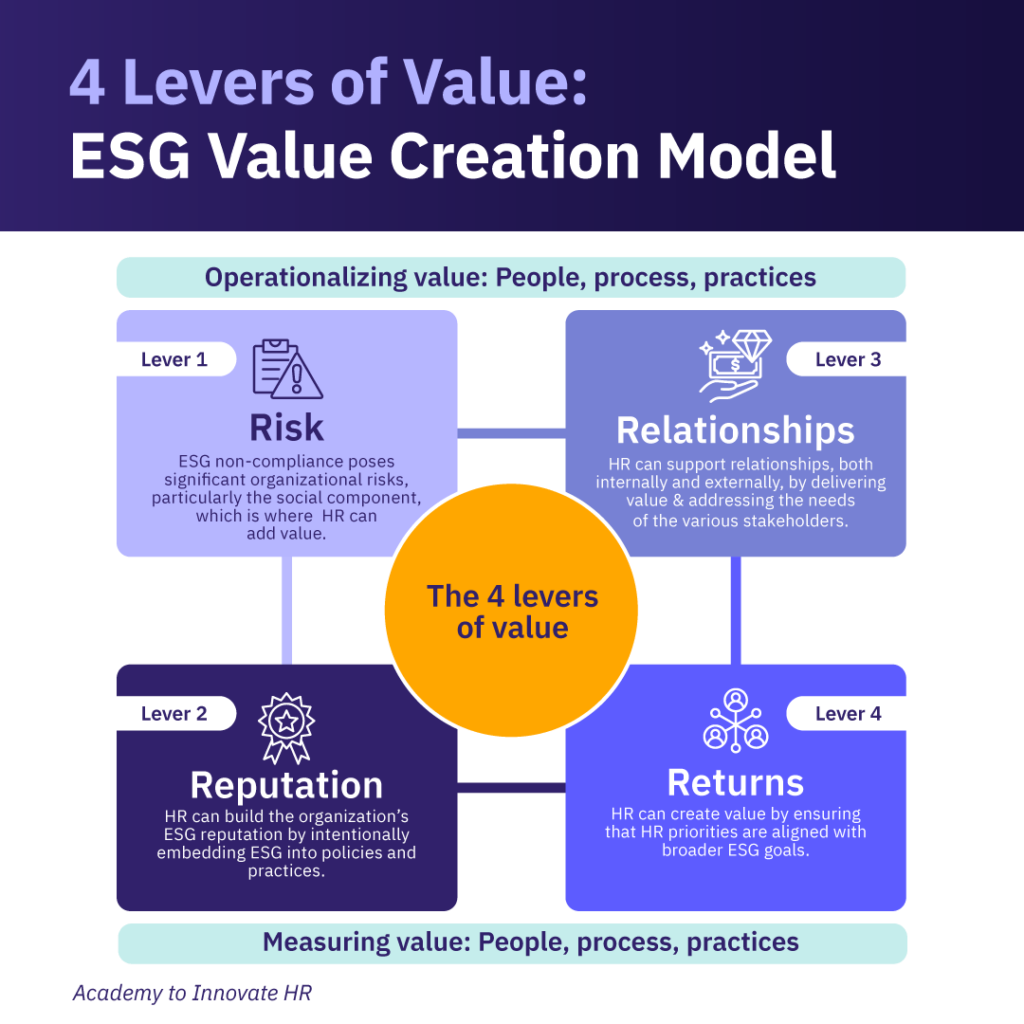ESG (Environmental, Social, and Governance) initiatives have become a primary focus for organizations over the last decade. Today, almost all companies in the S&P 500 (99%) openly report on and share their ESG focus areas and progress, showing how important these factors are for successful organizations.
While 79% of business leaders recognize ESG as a critical driver of financial performance, less than half say their organization has an actionable ESG strategy. Publicly, many organizations have been accused of greenwashing, making false claims as to the legitimacy of their ESG efforts. This disconnect leaves organizations vulnerable to reputational damage, regulatory penalties, and disengagement from employees and investors.
For many years, HR has played a passive role in creating ESG value. HR leaders recognize its importance but haven’t been able to articulate effectively the role that HR can play in making ESG practical and translating high-level strategies into tangible value.
In this article, we will examine ESG value creation and how HR can deliver value through practices, policies, and people. We unpack risk, reputation, relationships, and returns as value outcomes and outline the steps HR leaders can take to shift ESG initiatives from performative to transformative.
We’ve also developed a free ESG value statement template to use as a base for HR’s value creation statement.
Understanding ESG value creation
ESG value creation refers to how an organization aligns its business strategies with sustainability principles to generate tangible benefits across environmental, social, and governance dimensions. For HR, ESG value creation is about how ESG goals can be embedded within the HR agenda to unlock and create business value. For HR, ESG value in business is created by:
- Reducing risk: Through compliance with labor laws, ethical employment practices, and workplace sustainability measures.
- Enhancing reputation: By positioning the organization as a responsible employer that values sustainability, social equity, and ethical governance.
- Strengthening stakeholder relationships: By fostering trust and engagement among employees, customers, investors, and the wider community.
- Driving business performance: Through policies and programs that improve employee wellbeing, attract diverse talent, and optimize operational efficiency.
ESG value creation vs. ESG participation
While creating ESG value seems straightforward, execution is often complex. HR often participates in ESG-related projects, with little explicit focus on embedding ESG into the ways that HR ‘does business.’ While “participation” is essential, it remains largely reactive and only serves the purpose of compliance and risk management. A more proactive approach to value creation needs to complement these activities for HR to add impact and value through ESG.
The main differences between ESG participation and ESG value creation are highlighted below.
Passive involvement in ESG initiatives, primarily through compliance and reporting
Actively embeds ESG principles into workforce strategies and cultured
ESG is treated as a separate initiative, often led by sustainability teams
ESG is embedded into HR policies, talent management, and employee engagement
Compliance with ESG reporting, basic DEI programs, and ad-hoc sustainability efforts
Strategic alignment with business goals, creating measurable impact through HR-driven ESG initiatives
Employees are informed about ESG but not necessarily engaged
Employees actively contribute to ESG initiatives through aligned practices and incentives
Ensures minimal compliance with ESG-related labor laws and regulations
Proactively mitigates risks by fostering ethical practices, fair labor policies, and sustainable workplace operations
Supports external ESG branding efforts without embedding ESG into core HR functions
Builds internal and external credibility by ensuring ESG values are reflected in and HR operations
Limited engagement with employees, investors, and partners on ESG goals
Actively fosters relationships with stakeholders to ensure long-term ESG success
Primarily focused on meeting ESG reporting requirements to satisfy investors and regulators
Demonstrates tangible returns by aligning HR strategies with ESG goals to improve profitability, innovation, and talent retention
ESG value creation model for HR delivery
Successfully transitioning from ESG participation to ESG value creation requires a new approach.
To make this practical, we highlight an ESG value creation framework below that guides HR to move beyond ESG participation to sustainable value creation:

The ESG value statement: Defining what value means
Central to the model is the starting point of an ESG value statement for HR. This statement highlights why and how HR contributes to ESG and incorporates the organization’s commitment to ESG efforts. The ESG Value Statement has three parts:
- Why are we committing to ESG
- What we want to focus on as HR
- How we will achieve these outcomes.
ESG value statement example
- Why: “HR is committed to driving sustainable, inclusive, and ethical workforce practices that create a fair, sustainable, and thriving organizational environment.”
- What: Through responsible talent management, diversity and inclusion, employee wellbeing, and ethical governance, we ensure that our people and policies actively contribute to a resilient, purpose-driven, and future-ready organization.
- How: Our HR strategies foster trust, mitigate risks, enhance our reputation, and create long-term value for employees, investors, and society at large.
We’ve created an ESG value statement your HR teams can use as a foundation in developing HR’s ESG value statement.
4 levers of value
HR’s ESG value statement guides the ESG efforts of HR aligned to four key value levers: risk, reputation, relationships, and returns.
1. Risk
ESG non-compliance poses significant organizational risks. While the environmental and governance components of ESG compliance are usually taken care of by other departments, the social component refers to people-related aspects.
HR lever: The social component is often overlooked or not embedded in the organization, creating unnecessary organizational risk. However, HR can unlock significant value in this area.
2. Reputation
Despite good intentions, organizations face reputational risks and consequences when ESG is not supported or backed up by tangible actions. Here, it is about more than managing perceptions.
HR lever: HR can build the organization’s ESG reputation by intentionally embedding ESG into policies and practices, presenting another opportunity for value creation.
3. Relationships
Regarding ESG, the stakeholder landscape comprises employees, leaders, shareholders, and society.
HR lever: HR can support these relationships, both internally and externally, by delivering value and addressing the needs of the various stakeholders.
4. Returns
Returns refer to the monetary impact of ESG practices. This value is created for investors through good market performance, compliance, and positive net effect.
HR lever: HR can create value by ensuring that HR priorities are aligned with broader ESG goals, supporting organizational performance and profitability.
How HR can implement ESG value
Delivering value across these four areas requires HR to align practices, policies, and people to the ESG agenda and goals.
Let’s unpack each:
Practices
HR practices turn ESG into everyday actions and can operationalize ESG goals. From hiring and onboarding to performance management and training, these practices embed ESG into how the workforce operates.
For example, sustainable hiring practices reduce risk by ensuring compliance with labor standards while fostering a reputation for ethical behavior. Integrating DEI principles into training and development builds trust and loyalty among employees, strengthens internal relationships, and attracts talent aligned with the organization’s purpose.
Also, ESG-aligned performance management systems encourage accountability, improving outcomes that resonate with customers and investors.
Real-life example:
Starbucks’ HR practices exemplify ESG integration. Through its ethical sourcing initiatives and sustainable training programs, Starbucks educates employees about its commitment to sustainability. Additionally, HR incorporates ESG metrics into team performance reviews, reinforcing accountability for these goals at every level of the workforce.
Policies
HR policies provide the structural guidelines to align workforce behavior with ESG principles. These policies define expectations for ethical conduct, sustainability, diversity and inclusion, and employee wellbeing, creating the framework for accountability. Also, policies around travel, remote work, and workplace flexibility offer new opportunities for HR to influence ESG outcomes directly.
Real-life examples:
Deloitte has introduced sustainability-focused travel policies that encourage virtual collaboration as a default. For essential travel, employees are required to use specific tools to measure and offset their travel emissions. Companies like Shopify have adopted fully remote work models, significantly reducing office space usage and carbon emissions while creating more inclusive work environments. These HR-driven policy initiatives demonstrate how aligning work practices with ESG goals creates measurable value.
People
People are the heart of any organization’s ESG strategy. HR is critical in fostering an ESG-aligned culture by connecting people’s work to purpose and impact. Great Place to Work found that finding “meaning” in work is the most significant predictor of retention across generations — more than promotions, recognition, or even wages.
People who feel their employers positively impact the world are 11 times more likely to say they plan to stay with their organizations for the long haul and 14 times more likely to say they look forward to coming to work.
A workforce actively supporting sustainability and ethical practices enhances the company’s reputation, positioning it as a purpose-driven organization. Engaged employees also strengthen internal relationships, boosting retention, collaboration, and productivity. For investors, a motivated and values-driven workforce signals resilience and long-term viability.
Real-life example:
Patagonia demonstrates the power of aligning people with ESG goals. Its HR team actively recruits employees who share its environmental mission and equips them with opportunities to make an impact, such as paid time off for activism. Patagonia also invests in leadership development that emphasizes sustainable decision-making. This alignment strengthens the company’s ESG reputation and fosters a highly engaged and purpose-driven workforce.
How to measure ESG value: People, practices, and processes
In this model section, we define the key operational metrics that will demonstrate how the people, practices, and policies show our progress toward value. These metrics are more operational in nature and should all collectively contribute to the “Returns” value lever.
For example, organizations such as Apple, Chipotle, and Danone link executive pay to the achievement of ESG goals.
5 steps for HR leaders to get started
Defining an ESG value creation model for HR is more than just articulating the desired end state in your value statement. To ensure it adds value, here are five steps to get started:
Step 1: Understand the organization’s ESG strategy, goals, and desired outcomes
Conduct an assessment of the existing ESG strategy, identifying areas where HR can have the most impact. This involves reviewing sustainability reports, stakeholder expectations, and key risk areas.
Step 2: Define an ESG value statement for HR
The ESG value statement outlines how HR will contribute to the company’s ESG ambitions. This statement should articulate HR’s role in driving workforce sustainability, diversity, ethical business practices, and governance.
Step 3: Establish the four value levers you want to drive
These are Risk, Reputation, Relationships, and Returns. The levers determine key metrics to track progress. Define success indicators such as employee engagement in ESG initiatives, retention rates of diverse talent, and alignment with sustainability goals.
Step 4: Evaluate your current HR strategy, practices, and policies
Identify gaps that must be addressed. Assess how aligned these are to your ESG value statement and the value levers you identified. Use this input to make the necessary adjustments and prioritize actions.
Step 5: Incorporate ESG initiatives into the employer brand and Employee Value Proposition (EVP)
Including ESG initiatives in these will increase their visibility both internally and externally. Branding, recruitment messaging, and leadership advocacy will ensure that ESG commitments are communicated to employees, job candidates, and investors.
Final words
For ESG efforts to be successful, HR has to go beyond participation in ESG initiatives to focus on creating sustainable value. The ESG Value Creation Framework provides a roadmap for HR to move beyond compliance and reporting, ensuring that ESG becomes a fundamental part of the organization’s DNA.








